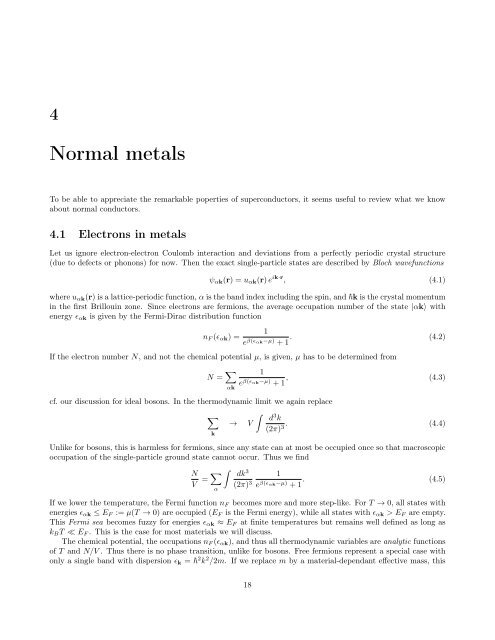Carsten Timm: Theory of superconductivity
Carsten Timm: Theory of superconductivity
Carsten Timm: Theory of superconductivity
Create successful ePaper yourself
Turn your PDF publications into a flip-book with our unique Google optimized e-Paper software.
4<br />
Normal metals<br />
To be able to appreciate the remarkable poperties <strong>of</strong> superconductors, it seems useful to review what we know<br />
about normal conductors.<br />
4.1 Electrons in metals<br />
Let us ignore electron-electron Coulomb interaction and deviations from a perfectly periodic crystal structure<br />
(due to defects or phonons) for now. Then the exact single-particle states are described by Bloch wavefunctions<br />
ψ αk (r) = u αk (r) e ik·r , (4.1)<br />
where u αk (r) is a lattice-periodic function, α is the band index including the spin, and k is the crystal momentum<br />
in the first Brillouin zone. Since electrons are fermions, the average occupation number <strong>of</strong> the state |αk⟩ with<br />
energy ϵ αk is given by the Fermi-Dirac distribution function<br />
n F (ϵ αk ) =<br />
1<br />
e β(ϵ αk−µ)<br />
+ 1 . (4.2)<br />
If the electron number N, and not the chemical potential µ, is given, µ has to be determined from<br />
N = ∑ αk<br />
1<br />
e β(ϵ αk−µ)<br />
+ 1 , (4.3)<br />
cf. our discussion for ideal bosons. In the thermodynamic limit we again replace<br />
∑<br />
∫<br />
d 3 k<br />
→ V<br />
(2π) 3 . (4.4)<br />
k<br />
Unlike for bosons, this is harmless for fermions, since any state can at most be occupied once so that macroscopic<br />
occupation <strong>of</strong> the single-particle ground state cannot occur. Thus we find<br />
N<br />
V = ∑ ∫<br />
dk 3 1<br />
(2π) 3 e β(ϵ αk−µ)<br />
+ 1 . (4.5)<br />
α<br />
If we lower the temperature, the Fermi function n F becomes more and more step-like. For T → 0, all states with<br />
energies ϵ αk ≤ E F := µ(T → 0) are occupied (E F is the Fermi energy), while all states with ϵ αk > E F are empty.<br />
This Fermi sea becomes fuzzy for energies ϵ αk ≈ E F at finite temperatures but remains well defined as long as<br />
k B T ≪ E F . This is the case for most materials we will discuss.<br />
The chemical potential, the occupations n F (ϵ αk ), and thus all thermodynamic variables are analytic functions<br />
<strong>of</strong> T and N/V . Thus there is no phase transition, unlike for bosons. Free fermions represent a special case with<br />
only a single band with dispersion ϵ k = 2 k 2 /2m. If we replace m by a material-dependant effective mass, this<br />
18

















